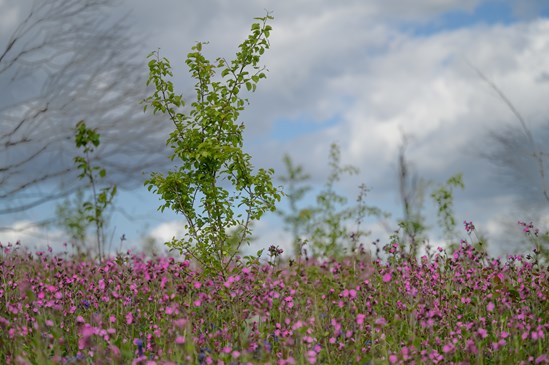Photos and video released by HS2 this Spring, show new wildlife habitats around South Cubbington Wood in Warwickshire bursting into life - with bluebells, red campions, primroses, violets, grasslands and ponds creating a vivid new landscape for people and wildlife to enjoy.
Over the last two years, HS2’s enabling works contractor LM JV (Laing O'Rourke and J. Murphy & Sons) has planted 60,000 trees in the Cubbington area, including oak, hazel, birch, holly and hawthorn.
Seven new ponds are attracting swallows and swifts and are now home to newts, frogs and insects. There are also refuges and basking banks for reptiles, bat boxes and fruit trees which will grow more quickly than other trees to provide potential bat roosting habitat.
One of the most interesting sights this Spring is the blanket of bluebells and campions which have grown from the soil that was translocated during HS2’s preparation works for the new railway in 2020. The technique means that wild seeds are in the soil when it’s carefully moved, allowing them to grow in their new location.
Around 17 hectares of habitat have been created around South Cubbington, including over six hectares of broadleaved wood linking the habitats of South Cubbington Wood and the River Leam Corridor. It also includes approximately two hectares of translocated ancient woodland soils to join up South Cubbington Wood and Weston Wood.
Like many of HS2’s new sites, parts of the new habitats have public rights of way, so local people are able to enjoy walking through this colourful new landscape.
James Hicks, HS2’s Biodiversity Policy Specialist said:
“We’re really pleased to see such an array of wildlife in our mitigation sites around South Cubbington Wood. The density and range of the wildflowers in the area is especially exciting, showing how translocated soils are showing regrowth including ground fauna from the ancient woodland.
“Through our extensive environment programme, we aim to leave behind habitats that can sustain healthy populations of UK flora and fauna, creating a network of bigger, better-connected, climate resilient habitats and new green spaces for people to enjoy.
“Over 100 new wildlife habitats across Phase One are already ensuring HS2 protects the country’s precious biodiversity and leaves a lasting legacy for local communities.”
In addition to the habitats already created during early works, HS2’s construction partner, Balfour Beatty VINCI Joint Venture, and their environmental partners are planting around 12 hectares of woodland near South Cubbington Wood and around a further 18 hectares - about the area of 15 football pitches of trees across the wider Cubbington area.
Across the wider Midlands region, over 220,000 trees have already been planted and 40 ponds created, along with many acres of new wetland, heathland and meadow. HS2 has also built homes for wildlife like badger setts, bat houses, bird boxes and reptile banks which help local wildlife thrive and support the delicately balanced local ecosystems.
ENDS

